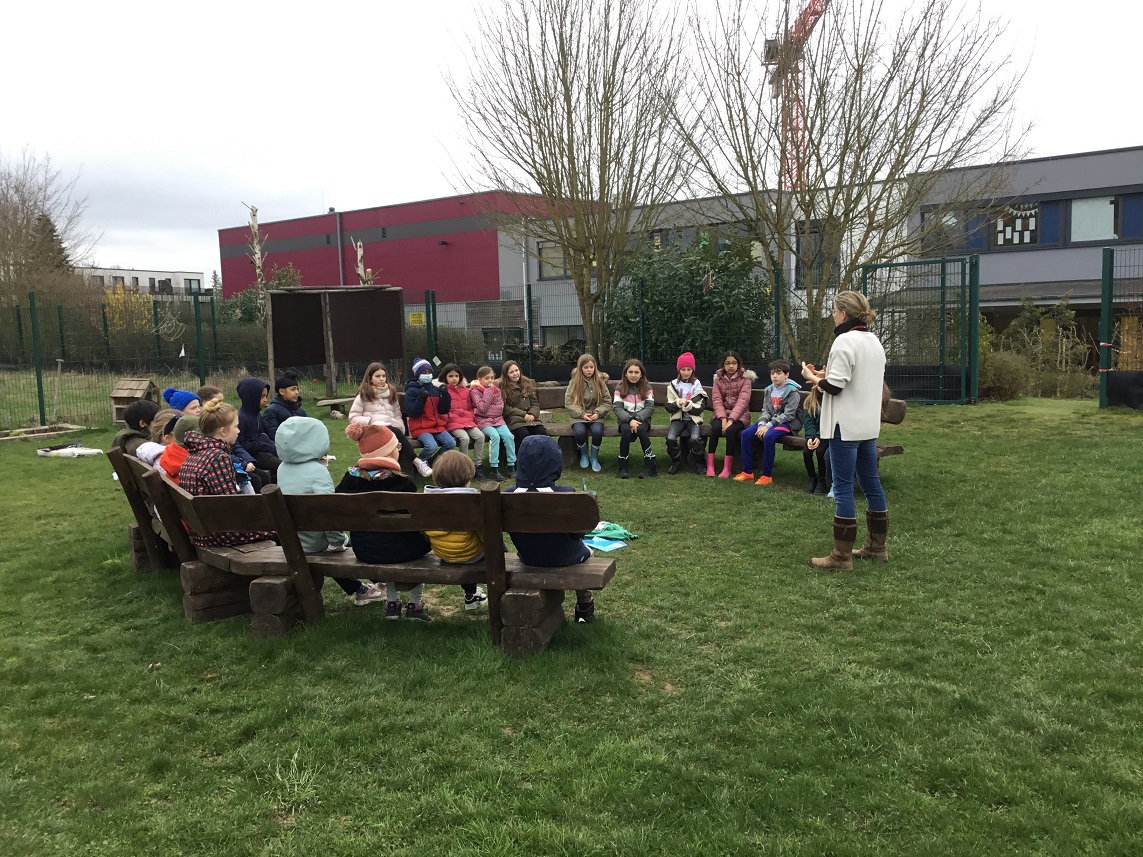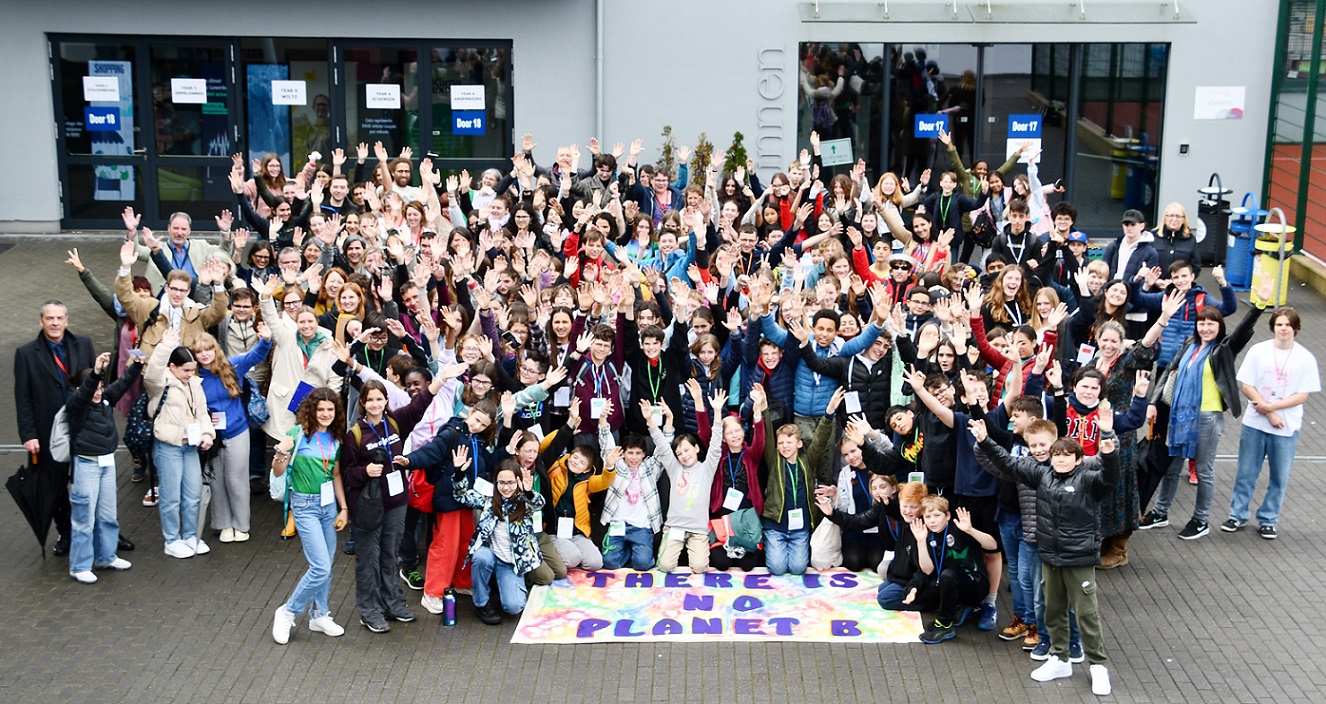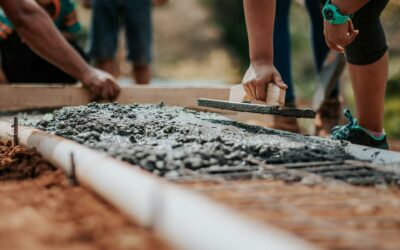With Anne-Marie McHugh, Sustainability Coordinator at St George’s International School, Luxembourg
Our school is an inclusive, vibrant international community of approximately 850 students aged from 3 years to 18+ years, representing over 60 different nationalities. This rich diversity provides a unique and exciting learning environment for every child. To prepare our students to be outstanding 21st century global citizens, we nurture strong values in our students, based on mutual understanding and respect.
Great to meet you! First things first – please tell me about yourself, your studies and your work.
I’m from London and I worked in IT operations for 20 years. I originally studied law at university which I think has fueled my passion for justice and more recently, climate justice. Six years ago, I decided that I wanted to change careers and do something more vocational. I went back to university to complete a Master’s in Environmental Management. In addition, I created and ran a blog about sustainability, volunteered at several sustainability organisations, managed various campaigns to reduce plastic waste and completed an internship with the university investigating embodied energy and carbon emissions of buildings and ways to reduce them.
Currently working as a sustainability coordinator at St George’s International School in Luxembourg. I’m also a member of the Sustainability Group for the British Chamber of Commerce, and I am passionate about bringing schools and businesses together to discuss sustainability.

Can you tell me more about these sustainability campaigns you ran? What was that experience like?
I created a petition about the single-use plastic balloons in Delhaize’s supermarkets and used social media to canvas signatures. Following this, I sent the petition to the supermarket’s sustainability team and sent them the petition – with low expectations. Two weeks later, Delhaize replied: they agreed with the wastefulness and informed me that they had removed the balloons from all supermarkets in Luxembourg.
Another campaign was “March for Zero Waste”. This included daily Instagram posts during March, discussing ways to go zero waste. A teacher from the St George’s found my online campaign when researching educational material for zero waste. Following an exchange of information, I found out about an opening at the school for my current role as Sustainability Coordinator. You never know where such little things might lead to.
That’s very much the nature of sustainability: there’s opportunity in anything.
Really interesting, thank you for this insight. Now, in order to better understand your work at the St George’s International School, could you tell me what distinguishes it in your opinion, what makes it special?
The simplest way to describe the school is that it hasn’t lost touch with that start-up mentality. The school is around 32 years old, and it started with 10 students in a small building set up by parents who wanted to give a British education to expat children overseas. It has nearly 900 students and an impressive campus, but that energetic start-up mentality remains.
This is evident in St George’s approach to sustainability. We are the first school in Luxembourg to sign up to strive for Eco-School accreditation, and the first school to appoint a sustainability coordinator. I have found that the school is open and listens to ideas, no matter how alternative. There is also a genuine sense of wanting to be a global citizen, wanting to be responsible and driving to be change makers. At every level in the community, from the students, teachers, staff, parents, governors etc.
And what would you define as the key sustainability areas of the school?
Our approach has evolved; the areas change each year as opportunities develop.
The first year was mainly concerned with identifying opportunities. The second year focused on setting up the school pledge with the simple approach of three key goals: go net zero, protect and support biodiversity and be smart about our resources.
In the simplest form, it’s looking at these three areas – but how you do it is complex and vast, ranging from the sustainable meals in the canteen, reducing operational energy, investigating car-pooling options, weaving the SDGs and sustainability into the curriculum, promoting school trips using public transport, setting up eco-clubs for students, shifting to more sustainable school resources etc…. The school is taking many actions and running numerous projects to promote sustainability, but they essentially centre around these three pillars of the pledge.
The goal is to create a sustainability vibe in the school community and try to provide good examples around the students. Hopefully, this inspires them, and they act on it, which is better than just pushing the topic on students in lessons.
Interesting! And how was this school pledge founded and determined?
To quote David Attenborough when tackling the Climate Crisis:
“Our motivation should not be fear but hope.”
The pledge offers us this hope. It’s also a tool to bring people’s focus back to basics. The pledge was also scheduled to coincide with COP26. This was a big event in British education then and offered the opportunity to bring the conversation loud and clear into our daily lives. This timing means we are reminded to follow COP each year and reflect and “check in” on our pledge annually.
How is the sustainability topic organized, in terms of governance? Is it driven by the school’s Climate Action students and staff, or how does it actively work? Is this a voluntary effort by each participant or is it part of the syllabus?
Our approach is organic and touches every point, at every level from classroom, to playtime to canteen to board level. Sustainability is a web reaching every facet of school life.
In our primary school, we have 25 Eco-agents students who meet each week in our outdoor garden to work on a variety of eco-projects, from planting trees to upcycling plastic bottles into our greenhouse, composting or managing our solar-powered irrigation for the veggie patch. We aim to feed these student-led projects into lessons the following year.
In secondary school, students can take action via the Ministry of Climate Action. Again managing diverse projects within the school, from reducing single-use plastic to running a thrift shop of second-hand clothes for Christmas presents.
The primary and secondary schools each have a teaching staff appointed as sustainability ambassadors, who have the task of helping identify opportunities in the curriculum for sustainability. This helps us weave ideas into the school and the lessons. This also helps return information from the students and staff about what works and what does not!
Our senior management team is also very passionate about sustainability and added sustainability objectives to the school development plan for the next three years, which links back to the pledge. We also have sustainability champions on our board of governors who support sustainability at the board level.
Finally, this year we also set up a Greener Buildings & Energy Committee, which focuses on reducing the carbon footprint from an operational perspective.
It’s a program of work with many stakeholders, essentially a web of activity, and it’s not driven by one team, which I think is reflective of sustainability: it’s a foundation for everything.

What’s the status quo of the carbon emissions, in terms of the School Climate Pledge to significantly reduce them? Which of the measures were easy to implement, and which turned out to be more challenging?
My dissertation on emissions of schools, and I built a carbon calculator for the school, estimating scope 1, 2 and 3 emissions. Whilst it is still an estimate, our emissions were roughly 800 CO2-equivalent tons per year from 2016 to 2019. Unfortunately, 2021 saw an increase to closer to 900 due to the impact of Covid (including opening the windows while heating for circulation) increased energy bills and emissions.
Reducing the emissions is not easy. There is no quick win, all actions require research and testing, and typically greener alternatives come at a green premium. Nonetheless, we’ve managed to get our canteen to do planet-friendly meat-free meals one day a week. Food is a really emotive subject, but this measure reduced our annual emissions by 40 tons annually. We also switched all our school paper to recycled paper and set up recycling for all school plastic stationery items.
The school has commissioned the building of a new school gym, which will increase our emissions, but we took action to change the heating system from a gas boiler to a heat pump system and populate the roof with solar panels. This should significantly reduce future emissions. Initially the new building would’ve generated 30 tons per year, but switching to a heat pump should reduce this down to 7 tons per year.
We’ve also looked at electric buses, but unfortunately, they’re not readily available in Luxembourg for private use. Hopefully, we can pilot this in the next two to three years as soon as it’s available.
This year, we’re working on replacing the LED lights throughout the school, investigating carpooling apps, and options to reduce and offset flights for school trips.
Carbon offsetting is controversial, but we’ve examined a few campaigns to find the right, trustworthy one. We’ve partnered with a school in Gambia in a project to learn about the global south, and we’re trying to support a reforestation project there, but that takes time to implement concrete programs.

How do you see the impact of the sustainability changes on the students themselves, as well as their participation in the various projects at school? Are you changing your community’s – kids, teachers, parents, … – behaviours?
To be clear, I am not changing anyone! The school community is coming together; everyone can see the need to become more sustainable. My role is to facilitate and help create opportunities and support student projects.
This year St George’s International School Luxembourg held a sustainability symposium, which seven schools attended, to learn about climate change and develop practical skills to take action. The event brought together over 150 secondary school pupils and guest speakers and 15 organisations working in sustainability in Luxembourg for workshops, discussions and networking on sustainability, climate change and the environment.
It was a powerful day that brought much energy and partnerships for the future. Testimonials by the students spoke about a feeling of empowerment and clarity and immediate action we can all take.
I hope this will lead to students driving more campaigns. We’re still at the early stages, but there’s definitely more awareness and a lot of the projects are getting their own legs. We’re still in the listening stage, making students feel empowered to come to us with ideas.
The most important contribution we can make is to ensure everyone feels like they can be a changemaker for the better and that no one feels left behind.
And where do you see the key difficulties of tackling the climate crisis at school? Is it often an issue of resources, or rather capacity, or something else entirely? Are there political issues?
There are a few difficult areas, one being time availability of the staff. Anything they do for sustainability is above and beyond, so trying to weave it in is challenging. Also, curriculums set by the UK education system still only have a limited coverage of sustainability, so laying it on top takes time, effort and innovation!
Also, there’s a lot of scepticism and assumptions of greenwashing, which is fair given the level of greenwashing around us. Nonetheless, I cannot emphasise enough how genuine it as a focus for the school. It’s almost about reassuring students and gaining their trust because the youth have a lot of climate anxiety and understandable scepticism.
Funding is another topic because sustainable alternatives are typically more expensive – paying for this is challenging.
There are very few political issues at the school regarding sustainability, as enough interested people are around to get momentum. I’d say within Luxembourg; it can be a challenge trying to get that connection with the community because international schools are treated differently and probably kept in more isolation. We’ve worked really hard on that this year and succeeded at connecting more with outside organisations in sustainability.
Can you tell me about your favorite sustainability project(s) at school and about the impact it had on you and the other participants? I see that there are quite a few ongoing and past projects, very great initiatives!
Of course! I will give you an overview of some of the work done by our amazing students, but I can’t list it all:
- School Greenhouse: Made from 1,500 recycled plastic bottles. Students from across the school helped work the 300hrs to build this.
- Our primary students even created an e-book , How To Save The World When You Are 9-10!
- Outdoor classroom: Requested by students and made from upcycled materials.
- School Veggie Patch: Primary students grow pumpkins, sunflowers, strawberries and much more
- Seed bombs and insect hotels: Requested by students and made from recycled materials.
- Eco-agents: In both primary and secondary school campaign to save energy by turning off lights and recycling all waste where possible.
- Green Wall: Primary students are planting trees to build a Greenwall of Luxembourg
- Forest School: Nursery students attend forest school learning about nature and protect the planet
- Christmas Thrift Shop: The Climate Action of Ministry promoted second-hand clothing to raise money for charity
- Kitchen Garden Club: Secondary students meet each week to learn about sustainable gardening and cooking
These student-led projects help support the school climate pledge to (1) Reduce Emissions (2) Protect Biodiversity, and (3) Be smart with resources.
What would be your advice to other schools and educational facilities striving to become more sustainable? And to parents who care about the environmental and social impact of the school their children attend?
I’d say talk about it, ask about it, campaign and connect.
Just take action in any way, you never know where it’s going to go, and you never know what asking about what the school is doing might trigger. And joining any campaign, no matter how small.
It’s all about connecting and sharing – we are stronger and better together.
Any last words for the Komoneed community?
Our school is always looking for inspirational speakers to talk to our students, so our priority for next year is looking at sustainability and innovation, spreading good news stories of what can be done.
Anyone that wants to reach out to us, you can send an email to sustainability@st-georges.lu and let us know. We’re always looking for people to inspire, by talking to students or hosting workshops, any way to spread these positive stories would be amazing.






A great example!… Think and act in sustainability, education comes first!
Yes! And it seems more like a simple, in-depth decision… Less discussion, more action!
Sustainability campaigns are indeed cool! One great example is the Trash Tag Challenge, where people clean up littered areas and post before/after photos. Its an awesome way to inspire others to take action and keep our planet clean. #DoYourPart
sustainability campaigns at school? That sounds super cool! Tell me more about it.
sustainability campaigns must have been such a cool experience! Tell me more!
its so cool to hear about sustainability campaigns at St Georges International School! How were they received by the students?
This article seems really insightful! Im curious, how do you measure the success of your sustainability campaigns?
I appreciate your enthusiasm, but measuring the success of sustainability campaigns can be a complex task. It involves analyzing various factors such as environmental impact, stakeholder engagement, and long-term behavior change. Its not as simple as counting likes or shares.
sustainability campaigns sound so cool! Can you share some creative ideas you implemented?
Thats great to hear! One creative idea we implemented was a Swap Shop where people could exchange items they no longer needed, reducing waste. Another idea was a Meatless Monday initiative to promote plant-based meals. What about you? Any innovative sustainability initiatives youve come across?
sustainability campaigns sound amazing! Can you share any memorable moments from those experiences?
its so cool that St Georges International School has a Sustainability Coordinator! 🌍 #EcoWarriors
Interesting article! I wonder if St Georges International School uses renewable energy sources for sustainability?
I highly doubt it. Most schools dont really care about sustainability. Its all about cutting costs and maintaining the status quo. But hey, who needs a habitable planet, right?
Hi Kyra,
Sorry for the late reply! I am just rereading this article now.
At St George’s our electricity is soured from renewable sources from the grid.
We also are installing a solar farm on our new school building. This will deliver approximately 8% of school energy.
We also choose to install air source heat pump systems on new buildings.
We do heat old buildings with gas, so we dropped our heating down 2Cs and managed to reduce our related gas CO2 footprint by 20 Tons of CO2e.
Hey there! Im glad you find Anne-Maries sustainability campaigns awesome. While I dont have any tips to share myself, I suggest reaching out to her directly for some expert advice. Good luck with your own campaigns!
sustainability campaigns sound so cool! Can you share any fun stories or challenges you faced?
Sustainability campaigns have a huge impact on the school community! They create awareness, inspire students to make eco-friendly choices, and foster a sense of responsibility towards the environment. Its impressive to see how these campaigns bring positive change and unite students for a common cause. Keep up the good work!
I really think sustainability is crucial in the 21st century. Its awesome that St Georges International School is leading the way!